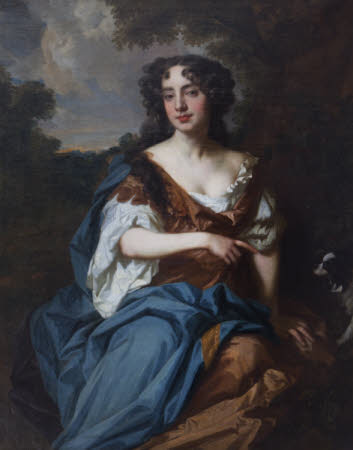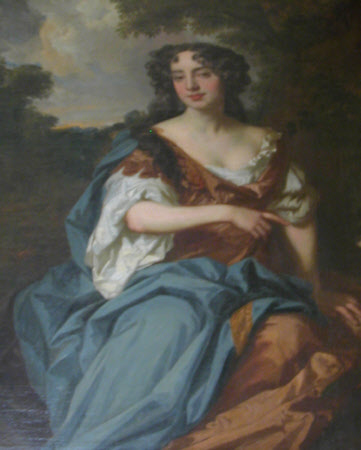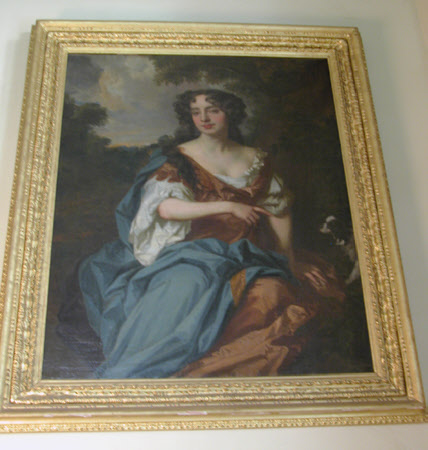Mary Ashe, Viscountess Townshend (1653-1685)
Sir Peter Lely (Soest 1618 – London 1680)
Category
Art / Oil paintings
Date
1673 - 1680
Materials
Oil on canvas
Measurements
1251 x 991 mm (49 1/4 x 39 in)
Order this imageCollection
Felbrigg, Norfolk
NT 1401203
Caption
The sitter was the younger sister of Katherine Ashe, wife of William I Windham. The portrait was painted soon after her marriage in 1673 to Horatio, 1st Viscount Townshend, but not at the same time or by the same artist as his portrait (although it is now framed and hung as its pendant). The prime version of the picture was last recorded as being from the collection of John Robert Townshend, Earl of Sydney (1805-90).
Summary
Oil painting on canvas, Mary Ashe, Viscountess Townshend (1653-1685) by Sir Peter Lely (Soest 1618 – London 1680) and Studio. Three-quarter-length portrait of a young woman, seated with a spaniel in a glade, wearing a blue wrap over a brown dress. Giltwood frame. Inscribed 'Lady Townsend. Copy of Lilly'. The younger sister of Katherine Ashe, wife of William Windham I, painted soon after her marriage in 1673 to Horatio, 1st Viscount Townshend.
Full description
The traditional identity of this portrait is almost certainly correct, but an anomaly attaches to it. This picture, the version formerly at Raynham, and the version formerly in the collection of Earl Sydney (of which there was a photo in the Witt Library when Beckett wrote, but which seems to have been misplaced since - unless it is the previously-noted sepia photograph of the picture when with Knoedler's), are all three identified as Mary Ashe, Viscountess Townshend, and all three have strong Townshend connections or provenances to make this identification plausible. However, there are two other pictures related to this portrait, with different names attached. Both are at Audley End, and are amongst the Cornwallis portraits from Brome Hall and Culford that were brought there in 1819 through the marriage of Lady Jane Cornwallis, daughter and co-heir of the 2nd Marquess, with Richard, 3rd Baron Braybrooke. One (inv. 480, Catalogue of the Pictures in the State Rooms by Richard Walker, 1973, pp. 34-35, No.12), which looks exactly the same as the present picture, bears no inscription, but has long been known as Jane Fox, Countess of Northampton (c.1660-1721). The other (inv. 475, Cat., p. 33, no. 7; Beckett No. 125), of a sitter with subtly different features and altered dress around her right arm and shoulder, and with no dog, has an inscription identifying the sitter as her sister, Elizabeth Fox, Lady Cornwallis (1655-80; m. Chas., 3rd Lord Cornwallis in 1673), and dating the picture to 1676. It appears from photographs to be superior to the previous portrait. There are, moreover, two further and distinct portraits of Elizabeth Fox, Lady Cornwallis: one, quite different in pose and rather so in feature, a three-quarter length as a shepherdess, in what was the collection of the Earl of Ilchester at Melbury (Beckett, No. 124); the other, a whole-length also at Audley End (inv. 662, Cat., pp. 2-3, No.2), of which the prime version is or was also at Melbury, inscribed with her identity and - significantly - the date 1676, which is quite different in type, but is evidently of the same sitter as the seated portait inscribed with the same identity and date (inv. 475). The most probable explanation for this is that the first Audley End portrait (inv. 480) is misnamed, and that it represents Mary Ashe, Viscountess Townshend. It is entirely plausible that a portrait of her should have been in the Cornwallis collection, since her granddaughter Elizabeth, daughter of the 2nd Viscount Townshend, married Charles, 1st Earl Cornwallis. Inv. 475 already appears as Elizabeth Fox, Lady Cornwallis in an inventory of 1780. Inv. 480 by contrast, presumably then bore another identification, or none at all, since no portrait is identified as that of Jane Fox, Countess of Northampton until the 1819 inventory of Brome Hall (in which inv. 475 also features). By that time, its similarity to inv. 475, of Lady Cornwallis, had caused the sitter to be christened as her sister, the Countess of Northampton, although it is in fact merely a studio copy of the present portrait - or rather of the original of the present portrait - and merely linked by a coincidence of pattern and a similarity of feature with inv. 475. Although the present picture has a label on the back, like No. 3, describing it as a "copy of Lilly", the term appears to be no more accurate in this case than it is in that. But whereas No.3 appears to be the case of another artist (?Sir Ralph Cole) simply borrowing a Lely pattern for a portrait with original features (though it may indeed be no more than a - variant - copy of the lost portrait of the 1st Viscount Townshend recorded by W.C. Edwards's etching), the case of the present picture, though of his wife, is very different. For its quality is such as to suggest that it is in fact an original - at least to the extent of the head, arms and hands, and some of the (particularly white) drapery - even though much else (especially the laying-in and the setting) of this oft-employed pattern may have been executed by studio assistants (an uninitialled correction on the Witt mount would assign the picture to Wissing). R.B. Beckett, however, (who seems to have been unaware of the existence of the present picture) firmly identified the presently unlocated version formerly in the possession of Earl Sydney as the original; and since his picture was presumably originally at Raynham (though this is not certain, especially in view of the other version there, enlarged to a whole-length), it is indeed likely that it would have been the prime version. It is therefore safest to describe the present picture, as its appearance would anyway - as analysed above -already suggest, as being by Sir Peter Lely & Studio. Like all the other autograph uses of this pattern for various sitters, it can plausibly be dated to around 1675, shortly after the sitter's marriage to Lord Townshend in 1673.
Provenance
1771 (Red Dressing Room): Lord and Lady Townshend; Part of the Windham Collection. The hall and contents were bequeathed to the National Trust in 1969 by Robert Wyndham Ketton-Cremer (1906-1969)
Makers and roles
Sir Peter Lely (Soest 1618 – London 1680), publisher



